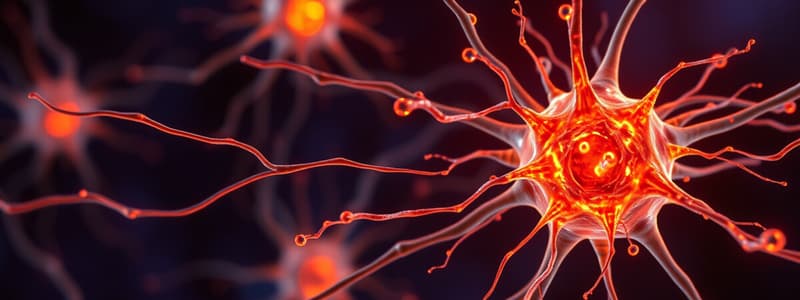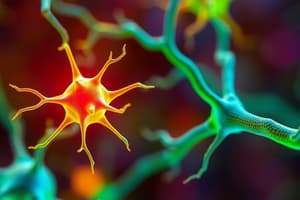Podcast
Questions and Answers
Which of the following neurotransmitters is classified as a biogenic amine?
Which of the following neurotransmitters is classified as a biogenic amine?
- GABA
- Glutamate
- Serotonin (correct)
- Acetylcholine
Which of the following statements is true regarding neurotransmitter removal from the synaptic cleft?
Which of the following statements is true regarding neurotransmitter removal from the synaptic cleft?
- A specific mechanism exists for their removal. (correct)
- Transporters are only found in the postsynaptic membrane.
- All neurotransmitters are removed via enzymatic breakdown only.
- Neurotransmitters diffuse away and are not recycled.
Which type of neurotransmitter includes amino acids?
Which type of neurotransmitter includes amino acids?
- Biogenic amines
- Gaseous neurotransmitters
- Peptide neurotransmitters
- Classical low molecular weight neurotransmitters (correct)
Which of the following neurotransmitters acts as a neuromodulator?
Which of the following neurotransmitters acts as a neuromodulator?
What is the role of nitric oxide in neurotransmission?
What is the role of nitric oxide in neurotransmission?
Which neurotransmitter is primarily associated with muscle activation at the neuromuscular junction?
Which neurotransmitter is primarily associated with muscle activation at the neuromuscular junction?
What is the primary effect of EPSPs on the post-synaptic membrane?
What is the primary effect of EPSPs on the post-synaptic membrane?
What determines the final response of a post-synaptic cell during synaptic integration?
What determines the final response of a post-synaptic cell during synaptic integration?
Which of the following correctly describes the pathway formed by motor neurons?
Which of the following correctly describes the pathway formed by motor neurons?
Which of the following ions typically contributes to the hyperpolarization observed in IPSPs?
Which of the following ions typically contributes to the hyperpolarization observed in IPSPs?
Which criterion is NOT necessary for a substance to qualify as a neurotransmitter?
Which criterion is NOT necessary for a substance to qualify as a neurotransmitter?
What is the primary role of neurotransmitters?
What is the primary role of neurotransmitters?
What is the primary neurotransmitter released by post-ganglionic sympathetic neurons?
What is the primary neurotransmitter released by post-ganglionic sympathetic neurons?
Which part of the nervous system is responsible for the 'rest and digest' response?
Which part of the nervous system is responsible for the 'rest and digest' response?
What is the typical composition of a synapse in terms of protein involvement?
What is the typical composition of a synapse in terms of protein involvement?
Where do pre-ganglionic sympathetic neurons originate from?
Where do pre-ganglionic sympathetic neurons originate from?
Which of the following statements about the neuromuscular junction (NMJ) is true?
Which of the following statements about the neuromuscular junction (NMJ) is true?
What primarily determines the type of neurotransmitter released by a neuron?
What primarily determines the type of neurotransmitter released by a neuron?
What effect does the sympathetic nervous system have on the heart?
What effect does the sympathetic nervous system have on the heart?
Which neurotransmitter is released at the neuromuscular junction?
Which neurotransmitter is released at the neuromuscular junction?
Which physiological response occurs when the parasympathetic nervous system is activated?
Which physiological response occurs when the parasympathetic nervous system is activated?
What role do dendritic arborizations play in neuronal function?
What role do dendritic arborizations play in neuronal function?
Study Notes
Sensory and Motor Neurons
- Sensory neurons create a divergent pathway, transmitting signals away from sensory receptors.
- Motor neurons form a convergent pathway, integrating multiple signals to elicit a response.
Synaptic Potentials
- EPSPs (Excitatory Post-Synaptic Potentials)
- Depolarize the post-synaptic membrane.
- Typically result from increased permeability to Na+ or Ca2+.
- IPSPs (Inhibitory Post-Synaptic Potentials)
- Hyperpolarize the post-synaptic membrane.
- Generally caused by increased permeability to Cl- or K+.
Synaptic Integration
- Post-synaptic cells can receive thousands of synaptic inputs, both excitatory and inhibitory.
- Interaction between EPSPs and IPSPs through synaptic integration leads to the final cellular response.
Neurotransmitter Characteristics
- Over 50 different neurotransmitters exist; neurons are named according to the neurotransmitter they release (e.g., cholinergic, noradrenergic).
- Criteria for Classification as a Neurotransmitter:
- Synthesized in the neuron.
- Present in the presynaptic terminal in sufficient amounts.
- Mimics action of endogenously released transmitter when applied externally.
- Has a mechanism for removal from the synaptic cleft.
Common Neurotransmitters
- Classical Neurotransmitters:
- Acetylcholine
- Noradrenaline
- Adrenaline
- Dopamine
- Serotonin (5-HT)
- Histamine
- Glutamate
- GABA
- Glycine
- Other potential neurotransmitters include ATP, adenosine, nitric oxide, and over 50 peptide neurotransmitters.
Autonomic Nervous System Functions
- Sympathetic Division:
- Dilates pupils, increases heart rate and force, constricts arterioles (excluding skeletal muscle and coronary circulation), relaxes bronchial smooth muscle, reduces gut motility, stimulates liver processes (glycogenolysis and gluconeogenesis), and relaxes the bladder.
- Parasympathetic Division:
- Constricts pupils, decreases heart rate and force, contracts bronchial smooth muscle, increases gut motility, relaxes sphincters, and contracts the bladder.
Pre and Post-Ganglionic Neuron Functions
- Sympathetic Nervous System:
- Pre-ganglionic neurons exit the thoracic and lumbar regions, synapsing near the spinal cord, using acetylcholine (ACh).
- Post-ganglionic neurons release noradrenaline (NA) at effectors.
- Parasympathetic Nervous System:
- Pre-ganglionic neurons exit from the brainstem and sacral region, synapsing near effector organs, also using ACh.
- Post-ganglionic neurons remain cholinergic, releasing ACh.
Synaptic Anatomy and Transmission
- Neurons can form ‘1 to 1’ or ‘1 to many’ synapse contacts.
- Synaptic structure is complex, involving numerous proteins for structural roles and molecule trafficking.
- Dendritic arborization is essential for neuronal function and connectivity.
Neuromuscular Junction (NMJ)
- NMJ is a specialized synapse between α-motor neurons and muscle fibers, with each neuron synapsing with several fibers, forming a motor unit.
- α-motor neurons originate from the CNS and are characterized by fast, myelinated fibers.
- ACh is the neurotransmitter at the NMJ, and it's distinct due to its association with Schwann cells.
Reflex Action
- The myotatic reflex, such as the knee-jerk reflex, illustrates basic synaptic transmission and neuromuscular interaction in response to stimuli.
Studying That Suits You
Use AI to generate personalized quizzes and flashcards to suit your learning preferences.
Related Documents
Description
Explore the intricate functions of sensory and motor neurons, including the divergent and convergent pathways they form. This quiz also delves into excitatory and inhibitory post-synaptic potentials (EPSPs and IPSPs), and their roles in neuron communication. Test your understanding of these essential concepts in neuroscience.




